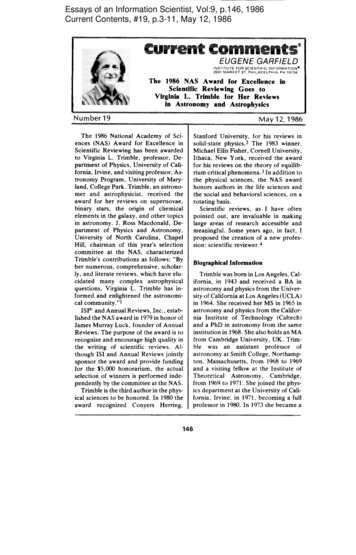
Transcription
Peck J, Slovek A, Miro P, et al. A Comprehensive Review of Viscosupplementation inOsteoarthritis of the Knee. Orthopedic Reviews. 2021;13(2). doi:10.52965/001c.25549ReviewsA Comprehensive Review of Viscosupplementation inOsteoarthritis of the KneeJacquelin Peck, MD 1, Annabel Slovek, AGACNP 2, Paulo Miro, BS 3, Neeraj Vij, BS 3, Blake Traube, BS 3, Christopher Lee,aMD 4 , Amnon A. Berger, MD, Ph.D. 5, Hisham Kassem, MD 1, Alan D. Kaye, MD, Ph.D. 6, William F. Sherman, MD, MBA 7,Alaa Abd-Elsayed, MD, MPH 81Department of Anesthesiology, Mount Sinai Medical Center, Miami Beach, FL, 2 Valley Anesthesiology and Pain Consultants – Envision PhysicianServices, Phoenix, 3 Department of Anesthesiology, University of Arizona College of Medicine-Phoenix, AZ, 4 Department of Internal Medicine,Creighton University School of Medicine-Phoenix Regional Campus, Phoenix, AZ, 5 Department of Anesthesia, Critical Care, and Pain Medicine, BethIsrael Deaconess Medical Center, Harvard Medical School, Boston, MA, 6 Department of Anesthesiology, Louisiana State University Shreveport, LA, 7Department of Orthopaedic Surgery, Tulane University, New Orleans, LA, 8 Department of Anesthesiology, University of Wisconsin School of Medicineand Public Health, Madison, WIKeywords: hyaluronic acid, sodium hyaluronate, degenerative joint disease, osteoarthritis, injection therapy, chronic painhttps://doi.org/10.52965/001c.25549Orthopedic ReviewsVol. 13, Issue 2, 2021Purpose of ReviewThe purpose of this systematic review is to discuss emerging evidence in the field ofviscosupplementation for chronic knee pain secondary to Osteoarthritis (OA). This reviewfocuses on types of viscosupplementation that are clinically available currently, evidenceto support their use, contraindications, and adverse events.Recent FindingsOA, also known as degenerative joint disease, is the most common form of arthritis in theUnited States, affecting 54.4 million, or 22.7% of the adult population. The knee is themost common joint affected in OA, with up to 41% involvement, 30% in the hands, and19% in the hips. The pathophysiology of OA is complex, with contributing factorsincluding mechanical stress to the joint, as well as many person-specific factors such asgenetic susceptibility, ethnicity, nutrition, and sex. Treatment modalities include weightcontrol, exercise, non-steroidal and steroidal anti-inflammatory drugs, opioids,intra-articular platelet-rich plasma, placebo, corticosteroid injection, intra-articularviscosupplementation, and surgery. Viscosupplementation consists of injection ofhyaluronic acid (HA) into affected joints, intending to restore the physiologicviscoelasticity in the synovial fluid (SF) in the absence of inflammation. HA has also beenshown to downregulate pro-inflammatory factors, such as PGE2 and NFkB, and proteasesand proteinases known to break down the joint matrix.The contraindications for HA injection are similar to any other injection therapy, andadverse events are usually mild, local, and transient. Viscosupplementation (VS) iseffective over placebo and more effective than NSAIDs and corticosteroids in painreduction and improved functionality; however, guidelines recommend neither for noragainst its use, demonstrating variability in the existing evidence base.Current VS options divide primarily into native vs. cross-linked andlow-molecular-weight vs. high-molecular-weight. Current treatment options includeHylan g-f-20, Sodium Hyaluronate preparations (Suparts Fx, Euflexxa, Gelsyn-3,Durolane, Hyalgen), single-use agents (Gel-One, Synvisc-One, Monovisc), andHyaluronan (Orthovisc, Monovisc, Hymovic). They share a common safety profile, and allhave evidence supporting their efficacy. Their specific details are reviewed here.aCorresponding author:Christopher Lee, MDSt. Joseph Hospital & Medical CenterDepartment of Internal Medicine500 West Thomas RdPhoenix, AZ 85013Chrislee0621@gmail.com
A Comprehensive Review of Viscosupplementation in Osteoarthritis of the KneeSummaryOA is the most common form of arthritis. It is a chronic, debilitating illness with a highimpact on the functionality and quality of life of a significant part of the population in thewestern world. Treatments include medical management, physical therapy, activitymodification, injection, and surgery. VS effectively reduces pain, increases functionality,and delays surgery in the knee to treat osteoarthritis. While previous studies havedemonstrated variable results, more evidence is becoming available generally supportiveof the benefit of VS in the treatment of knee OA.INTRODUCTIONOSTEOARTHRITIS OF THE KNEEOsteoarthritis (OA), also known as degenerative joint disease, is the most common form of arthritis in the UnitedStates, affecting 54.4 million, or 22.7% of the adult population.1 Of those affected, studies have reported that 22.7million suffered from arthritis-attributable activity limitations.2 The economic burden associated with OA is significant and multifactorial, including costs related to treatment, hospitalizations, work-related losses, and home-carecosts.3 The knee is the most common joint affected in OA,with up to 41% involvement, compared to 30% in the handsand 19% in the hips.4,5 Knee OA, specifically, has doubledin prevalence since the mid-20th century, and has been estimated to have a lifetime direct per-person costs for symptomatic patients of 12,400.6,7 OA has also been shown tosubstantially decrease quality of life, with studies estimating 86 million quality-adjusted life-years lost due to kneeOA alone.8TREATMENT METHODSThe pathophysiology of OA is complex, with contributingfactors including mechanical stress to the joint and manyperson-specific factors such as genetic susceptibility, ethnicity, nutrition, and sex.9,10 Consequently, the range oftreatment options for the management of knee OA is alsomultifaceted. Treatment methods can be classified intothree major divisions: non-pharmacological, pharmacological, and interventional. Treatment modalities includeweight control, exercise, non-steroidal and steroidal antiinflammatory drugs, opioids, intra-articular platelet-richplasma, placebo, or corticosteroid injection, intra-articularviscosupplementation, and surgery.11 Interventional treatments for OA are the most recent of these, with viscosupplementation introduced in the late 19th century.VISCOSUPPLEMENTATIONViscosupplementation consists of injection of HA into affected joints, intending to restore the physiologic viscoelasticity in the synovial fluid (SF) in the absence of inflammation.12 SF is a solution found in the cavity of synovialjoints, with the primary role of minimizing friction betweenthe surrounding articular cartilage during movement.Hyaluronic acid (HA) is a naturally occurring and integralpart of healthy cartilage and SF. It is composed of repeatingdisaccharide units formed by N-acetyl-d-glucosamine andd-glucuronic acid. Bothner & Wik et al. showed that themolecular composition and rheological properties of HAare fundamental to the proper lubrication of joints.13 Inaddition to its lubricant properties, HA has many chondroprotective biochemical functions. Wang et al. showedthat HA down-regulated the expression of pro-inflammatory cytokines through its interaction with fibroblast-likesynoviocytes in the joint space.14 Furthermore, Yasuda etal. showed that HA suppresses macrophage production ofProstaglandin E2 via downregulation of NF-kappaB.15Lastly, Sasaki et al. showed that the expression and production of matrix metalloproteinases, proteases involvedin the degradation of matrix proteins that contribute tothe integrity of the joint, is decreased in the presence ofHA.16 Many hyaluronic acid derivatives are currently beingused in the treatment of knee osteoarthritis, whether be itcross-linked hyaluronic acid such as Hylan g-f 20, sodiumhyaluronate (the salt form of hyaluronic acid, which has asmaller molecular weight but greater molecular stability),or hyaluronan (a high molecular weight polysaccharidefound in hyaluronic acid).CONTRAINDICATIONS AND ADVERSE EVENTSContraindications to HA include known hypersensitivity toHA products, pediatric patients, bacteremic patients, andthose with active local infection in the articular target ofinjection. Adverse events associated with viscosupplementation are not well reported in the literature, and the onesreported have varied rates of incidence. Reported adverseevents include pain at the site of injection, local skin reactions, pseudoseptic reactions, septic arthritis, and localjoint pain and swelling.17EVIDENCE AND GUIDELINESA 2006 Cochrane Review, including seventy-six randomizedcontrolled trials evaluating viscosupplementation with a diagnosis of knee OA in at least one branch, supported theefficacy of viscosupplementation against placebo. The authors report beneficial effects on pain, physical function,and global assessment, with the strongest findings between5-13 weeks post-injection.18 In some studies, viscosupplementation was similarly effective compared to NSAIDs,with more prolonged effects than corticosteroids. However,the authors caution that there was insufficient sample sizeto definitively compare classes of viscosupplements. In addition, they stated that limited evidence suggests that differences may exist in both safety and efficacy between thetwo classes.Despite conclusions from the 2006 Cochrane Review,currently available guidelines and more recent meta-analyses and systematic reviews have conflicting recommendations. The latest guidelines published by the AmericanOrthopedic Reviews2
A Comprehensive Review of Viscosupplementation in Osteoarthritis of the KneeAcademy of Orthopaedic Surgeons (AAOS) in 2013 statethat HA for patients with symptomatic OA of the knee cannot be recommended noting that most of the literature surrounding viscosupplementation has a significant degree ofpublication bias.19 The 2014 Osteoarthritis Research Society International (OARSI) guidelines offer an “uncertain”recommendation for intraarticular HA in knee OA.20 Lastly,the American College of Rheumatology (ACR), in their 2012guidelines, states that they have no recommendations regarding the use of intraarticular hyaluronates.21 There havebeen several systematic reviews and meta-analyses withdiffering results as well. Rutjes et al. in 2012 concludedthrough a comprehensive systematic review and metaanalysis that viscosupplementation is associated with aclinically irrelevant benefit and an increased risk for adverseevents.22 In 2015, Richette and colleagues concludedthrough an updated meta-analysis of trials with low riskof bias that HA supplementation provided a moderate butreal benefit for patients with knee OA.23 The following year,Xiao et al. led a PRISMA-compliant systematic review of 12meta-analyses, concluding that HA is both an effective andsafe intervention in treating knee OA.24 Published guidelines surrounding the use of viscosupplementation remainuncertain, and data from meta-analyses or systematic reviews have been inconsistent. Furthermore, a wide varietyof hyaluronic acid derivatives are available and used intreating knee osteoarthritis, with little consensus on theclinical superiority of one agent over another.PURPOSEThe purpose of this systematic review is to discuss emerging evidence in the field of viscosupplementation forchronic knee pain secondary to OA. We discuss systematicreviews, meta-analyses, and randomized controlled trialsrelating to agents used for viscosupplementation and published within the past 5 years.HYLAN G-F-20Many viscosupplementation products exist. This sectionwill focus on Hylan g-f20 specifically. Two classificationsprimarily distinguish HA products from one another; nativevs. cross-linked and low-molecular-weight vs. high molecular weight HA. Hylan g-f20 is a cross-linked productderived from rooster comb HA, with a higher molecularweight (6000 kDa).25 Hylan g-f20 is marketed under thebrand name Synvisc and Synvisc-One. Synvisc is administered in three separate doses (2mL, 16mg each), whileSynvisc-one is administered once (6mL, 48mg).26 The difference is solely administration convenience, with no trialshowing a difference in efficacy between the two. Hylan gf-20 mimics naturally occurring HA reducing nociception,promoting synthesis of extracellular matrix proteins, andsuppressing inflammatory mediators.27 However, its uniquechemical properties may provide additional benefits. Wobiget al. concluded that the higher molecular weight of Hylang-f20 makes this product more elastoviscous compared toother HA preparations with lower molecular weights.28Wobig also suggested that the pain-relieving effect reportedin patients who receive viscosupplementation is directly re-lated to the elastoviscosity of the product used for intra-articular injection.28 Cross-linking of the formulation is alsointended to allow for longer-lasting efficacy by increasingresistance to degradation within the knee joint.SAFETY PROFILEExisting literature does not attribute any unique adverseevents to the use of Hylan g-f20 specifically. Two large studies suggest that the rate of mild adverse reactions does notincrease with the use of Hylan g-f20. In a recent metaanalysis, Zhao et al. compare Hylan g-f20 to lower molecular weight HAs and conclude that there is no evidenceof increased risk of treatment-related mild adverse eventswith Hylan g-f20 injections.29 In a multicenter longitudinalstudy conducted in 2015, Yan et al. report the adverse eventprofile of Hylan- g-f20 to be mild and self-limiting. The majority of events are local inflammatory reactions.30 Following a randomized controlled trial, Leopold et al. reportedthat local reactions to Hylan g-f20 occurred more often inthose receiving more than a single injection, raising concern for multiple-course treatment with Hylan g-f20.31Lastly, Goldberg and colleagues suggested that there maybe a higher incidence of pseudoseptic reactions with theuse of Hylan g-f20 compared to other HA preparations.32They hypothesize that Hylan g-f20 may have increased immunogenicity due to the chemical cross-linking of the molecule, as well as possible contamination from chicken proteins and other components of rooster combs during thecross-linking process.32 This hypothesis was supported byIshikawa and colleagues, who concluded that Hylan g-f20was less biocompatible and had higher immunogenicitycompared to a different cross-linked HA formulation, withcorrespondingly higher rates of pseudoseptic reactions.33EFFICACYThere have been several large, high-quality studies in thelast five years investigating the effectiveness of Hylan g-f20.Waddell et al. report that, from a large cohort of 1,863 patients with grade IV OA of the knee, 75% of patients receiving Hylan g-f20 injections delayed the need for total kneereplacement by 7 years or more.34 However, this study evaluated Hylan g-f20 alone and did not compare it to othertraditional treatments for OA or placebo. The authors alsofound a slight increase in knee synovitis with repeat injection, though the cases were generally mild or moderatein severity. Similarly, Kearey et al. concluded that singleinjection Hylan G-f20 led to clinically significant improvements in pain and function, with results most pronouncedat the 3-month and 6-month period.35 However, the authors suggest that the symptomatic relief provided by Hylang-f20 may be reduced as the patient’s age increases. Tammachote et al. concluded that a single injection of Hylang-f20 provided similar symptomatic relief at the 6 monthscompared to a single injection of corticosteroids, with thecorticosteroid injection resulting in better pain control andfunctional improvement in the early weeks following treatment.36 More recently, Dai and colleagues published ameta-analysis finding no clinically important difference inoutcomes, including pain relief and functional improve-Orthopedic Reviews3
A Comprehensive Review of Viscosupplementation in Osteoarthritis of the Kneement between Hylan and HA injections.37 Furthermore,they discouraged the use of Hylan over HA due to its highercosts. However, a similar study by Migliore and colleaguesindicated that Hylan g-f20 is a cost-effective treatment,even when compared to NSAIDs.38 This suggests that Hylang-f20 may be cost-effective when compared to pharmacologic treatment but cost-ineffective when compared toother viscosupplementation formulationsSUMMARYIn summary, the data suggests that Hylan g-f20 may be aneffective interventional treatment for knee OA and may delay time for total knee replacement surgery. The clinicalbenefit of Hylan g-f20 seems to be most clinically noticeable two to nine months following the initiation of treatment. Data comparing clinical benefits to other agents isconflicting, heterogeneous, and difficult to conclude due tostudies using different thresholds for determining a clinically significant difference. In terms of safety and adverseevents, Hylan g-f20 is not associated with a greater incidence of mild adverse events. Still, it may be associatedwith a greater incidence of pseudoseptic reactions, especially in those receiving multiple injections. The suspectedincreased immunogenicity associated with Hylan g-f20 mayrender it an inferior option for long-term intra-articulartreatment. Hylan g-f20 may be a suitable option in the elderly population who cannot tolerate pharmacologic treatment but may also experience decreased symptom relief asthe patient population age increases.SODIUM HYALURONATEBACKGROUNDSodium hyaluronate is a salt form of hyaluronic acid and isa glycosaminoglycan formed from long-chain disaccharideNa-glucuronate-N-acetylglucosamine units. It is a naturallyoccurring substance found within connective tissues. Whenused as a viscosupplement in treating knee osteoarthritis,it improves symptomatology by acting as a lubricant andshock absorber. Still, it has also shown benefit surpassing itsduration of action, which has been linked to anti-inflammatory properties.39 Preparations include Supports, Euflexxa,Gelsyn, Durolane, and Hyalgan. These are typically usedonce the first medical management has failed but may delaythe need for knee replacement surgery.39SUPARTS FXSUPARTZ FX is an injectable solution containing sodiumhyaluronate, a conjugated salt form of hyaluronic acid. Supartz Fx is derived from chicken combs extract and is givenweekly injections of 25 mg for 3-5 weeks. It has been shownto have a more significant benefit for both pain and functionwhen compared with other non-surgical treatments.40cross-linked and has an intermediate molecular weight of24,000-3,600 kDa. Euflexxa has been associated with adverse effects including joint pain, back pain, limb pain,muscle pain, and joint swelling. No literature evaluates theuse of Euflexxa in pregnant women or children less than 18years of age. However, it has been deemed safe and is FDAapproved for the remainder of the general population.41GELSYN-3Gelsyn-3 (Sinovial ) is non-crosslinked 0.84% sodiumhyaluronate of bio-fermentative origin and is administeredin a three-injection seriGelsyn, Durolane, es. As with anyinjection, risks include general knee pain, warmth, and redness at the injection site.42 In a randomized controlled trialevaluating Gelsyn-3 compared to Hylan G-F20, both preparations worked similarly well with patients experiencing approximately 32.5 point reductions in Western Ontario andMcMaster Universities (WOMAC) pain subscores at 26weeks. Both viscosupplements reduced joint pain and stiffness for up to 6 months, improved quality of life, and delayed the need for total knee replacement surgery.43DUROLANEDurolane is a single-injection product using a cross-linkedsodium hyaluronate agent derived from bio-fermentation,with a half-life of approximately four weeks. In a 2018meta-analysis, Leighton et al. found that Durolane providessignificant improvements in pain, physical function, andquality of life for knee osteoarthritis. They also foundDurolane to be superior or non-inferior to treatments including placebo, corticosteroids, Hylan G-F20, and multiinjection sodium hyaluronate. Leighton et al. found that23 of the 175 patients receiving Durolane experienced adverse effects including post-injection pain, joint swelling,and pseudoseptic reaction; however, these were consideredmild and transient.44HYALGENHyalgen is a high molecular weight hyaluronic acid product(500,000-730,000 daltons) derived from purified roostercomb extract. Because it is not cross-linked, it is given in20 mg doses over a 3-injection course. It has provided longlasting pain relief for up to 6 months and is safe for repeatuse up to 30 months. US clinical trials have shown adverseeffects including pain at the injection site, gastrointestinaldiscomfort, headaches, local ecchymosis, and pruritus. Because it is a purified fraction of sodium hyaluronate extracted from roosters, allergic and anaphylactic are slightlymore common than with many other HA viscosupplements.Though these adverse effects remain rare, physiciansshould exercise caution in the use of this product with patients with known allergic reactions to HA products.40,45EUFLEXXAADDITIONAL REVIEW ARTICLES, META-ANALYSES, ANDRANDOMIZED CONTROLLED TRIALSEuflexxa contains sodium hyaluronate developed using bacterial fermentation. It is given as weekly injections of 20mg, for a total of three injections. Like Supartz Fx, it is notEmerging research has demonstrated the clinical efficacy ofsodium hyaluronate in the treatment of knee osteoarthritis. A 2017 retrospective questionnaire-based survey con-Orthopedic Reviews4
A Comprehensive Review of Viscosupplementation in Osteoarthritis of the Kneeducted by Miller et al. found that a multimodal treatmentapproach—five weekly injections of Hyalgen, structuredphysical therapy, knee bracing, and patient education—resulted in a 60% reduction in WOMAC pain subscores andhad an incremental cost-effectiveness ratio (ICER) of 6,000per quality-adjusted life-year (QALY).46 However, nuancesin viscosupplement agent selection require additional investigation.Supartz Fx has been on the US market since 2001 andit is well established as an effective method for reducingpain and improving clinical outcomes for patients with osteoarthritis (OA.) Bannuru et al. 2016 sought to determinethe safety of repeat courses of SUPARTZ injections. Thissystematic review found SUPARTZ repeat injections to besafe with an overall adverse event rate of 0.008 (95% confidence interval of 0.001-0.055.), which supports repeat SUPARTZ injections in the symptomatic management of osteoarthritis in the knee.39,40 Curran et al. 2010 found nosignificant difference in the incidence of adverse effects between Supartz and control groups using phosphatebuffered saline.47 Further, data exists that suggests SUPARTZ may be beneficial in improving muscle strength, gaitpattern, and balance though further research is still neededto confirm these findings.39Single-use viscosupplementation agents are also available and attract growing consideration because of increasedcost-effectiveness and patient convenience with decreasedexposure to risks associated with knee injection, includinginjection pain, patient discomfort, injection-related inflammation, and erythema. Single-injection HA products currently available include Gel-One, Synvisc-One, and Monovisc.40 Conflicting evidence exists regarding the relativeeffectiveness of these agents. Al-Omran et al. showed 3injections of Synvisc to be statistically significantly moreeffective in improving than one 60 mg/3 mL injection ofDurolane in an initial double-blind, randomized study. Further, Diracoglu et al. 2016 showed Monovisc (a single doseinjection) to have no statistical differences compared toAdavant (3 standard linear injections) regarding VAS-painand WOMAC scores after the injections, but found singleinjection Monovisc to be significantly inferior at 6 monthsregarding VAS-pain scores.48 However, in a meta-analysisof single-injection products, Vincent et al. found mono-injections to produce results similar to multi-injections.49 Finally, in a 2017 meta-analysis including twenty-four studies evaluating weekly Hyalgan knee intraarticular injectionsover three vs. five weeks in 2168 cumulative study participants, Stitek et al. found no statistical difference betweenthe 3 and 5-week courses. This may support HA administration over fewer injections without diminishing clinical benefits. Given these varying results, further systematic analyses are needed to explore the use of single-injection HAproducts.50SUMMARYIntraarticular sodium hyaluronate injections appear to be asafe and effective treatment for symptomatic treatment ofOA. These agents provide a cost-effective alternative therapy for patients who have been unsuccessful with othernon-operative methods and have been deemed as safe andeffective among healthy adults. However, reported adverseeffects include arthralgia, arthropathy/arthrosis/arthritis,back pain, injection-site reaction/pain, and headache.47These reactions are generally mild to moderate in severity.39,40 The comparative efficacy of single-injection HAproducts has mixed results in the literature and requiresfurther n (HA) is a high-molecular-weight extracellularmatrix (ECM) polysaccharide and hyaluronic acid derivative, particularly in soft connective tissues.52 It has variousfunctions in development, growth, and tissue regeneration.Similar to Hyaluronic Acid, Hyaluronan is a polymer used asa viscosupplement that may directly modulate the expression of inflammatory genes via cell surface receptors - suchas CD4, RHAMM, and Toll-like receptors – and regulationof downstream signaling.52,53 Following synthesis via HAsynthases as a protein-free polysaccharide at the cell membrane, it may associate with receptors or diffuse across themembrane into the ECM, contributing to various biologicaleffects as part of complexes with specific binding proteins.HA may also be cross-linked to form matrices.52 These various macromolecular matrixes are implicated in the regulation of inflammatory cell migration and adhesion, acting asan influence on anti-inflammatory and pro-inflammatoryactivity. Aside from the potential roles of HA in inflammation pathways, the polymer acts as a viscoelastic shock absorber by virtue of its size, its presence in the ECM, and itsrheological properties.52,53Hyaluronan’s unique function as a viscosupplementationagent is traditionally attributed mainly to its viscoelasticproperties related to a high molecular weight and gel formulation. The viscoelastic properties attributed to hyaluronan contributed to its initial use as a viscosupplement.However, the additional benefit has been attributed to potential inflammatory and biological pathway enhancements.52,53 It is administered in treating knee osteoarthritis as an injection directly into the joint, where viscoelasticproperties work to reduce the mechanical forces and inflammatory pathways driving the pathogenesis and symptomatic presentation of arthritis.52 Machado et al. recentlysuggested that the clinical response to HA may depend onthe intrinsic properties of the polysaccharide, whetherhyaluronan or another similar polysaccharide, rather thanon the rheology.53 The mechanism of action behind viscosupplements is multifactorial and remains under evaluation.Risks associated with hyaluronan are mild and similarto those of other viscosupplements, including allergies, injection site pain and inflammation, infection, and potentialtemporary arthritic flares. Other rare side effects includeitching, numbness/tingling, headache, dizziness, and backpain.52,53Multiple brand-name formulations of hyaluronan areused for intraarticular injection in the management of kneeosteoarthritis. These include Orthovisc, Monovisc, and Hymovis. Several differences exist between formulations. Or-Orthopedic Reviews5
A Comprehensive Review of Viscosupplementation in Osteoarthritis of the Kneethovisc hyaluronan particles are derived from roostercombs, while Hymovis and Monovisc hyaluronan are extracted and purified from bacterial fermentation, free fromany animal proteins. Monovisc is administered as a singleinjection, while Hymovis is administered in 2 injections,and Orthovisc is administered in 3-4 injections spaced oneweek apart. Monovisc is considered moderate molecularweight and is cross-linked at time of injection, Orthovisc isdeemed to be moderate molecular weight and is not crosslinked at time of injection, and Hymovis is considered lowmolecular weight and is not cross-linked at time of injection.52SYSTEMATIC REVIEWS AND META-ANALYSESMultiple systematic reviews and meta-analyses have beenpublished recently about hyaluronan injections. In examining the use of intra-articular hyaluronan therapy vs.placebo, Richardson et al. ultimately concluded that thenumerous randomized controlled trials (RCTs) and metaanalyses demonstrated clinical benefit of hyaluronan generally that the active ingredient HA itself did not necessarilycause such benefit.52 The reviewers maintained that muchof the benefit was attributable to a placebo effect. The smallbenefit of hyaluronan over placebo found in some of theexamined studies was unknown clinical significance. Theauthors reported that hyaluronan was comparable to injectable corticosteroids for long-term relief, though less effective than injectable corticosteroids for more short-termbenefit, and concluded that it may be an appropriate and effective therapy.52Another meta-analysis by Yanhong et al. comparedplatelet-rich plasma (PRP) to hyaluronan injections forknee osteoarthritis. This study included fifteen RCTs andconcluded that PRP injections reduced pain more effectively than hyaluronan at both 6-month and 12-month follow-up periods and provided more functional improvementin individuals. They also found no significant difference inadverse effects in PRP vs.
the American College of Rheumatology (ACR), in their 2012 guidelines, states that they have no recommendations re-garding the use of intraarticular hyaluronates.21 There have been several systematic reviews and meta-analyses with differing results as well. Rutjes et al. in 2012 concluded through a comprehensive systematic review and meta-










